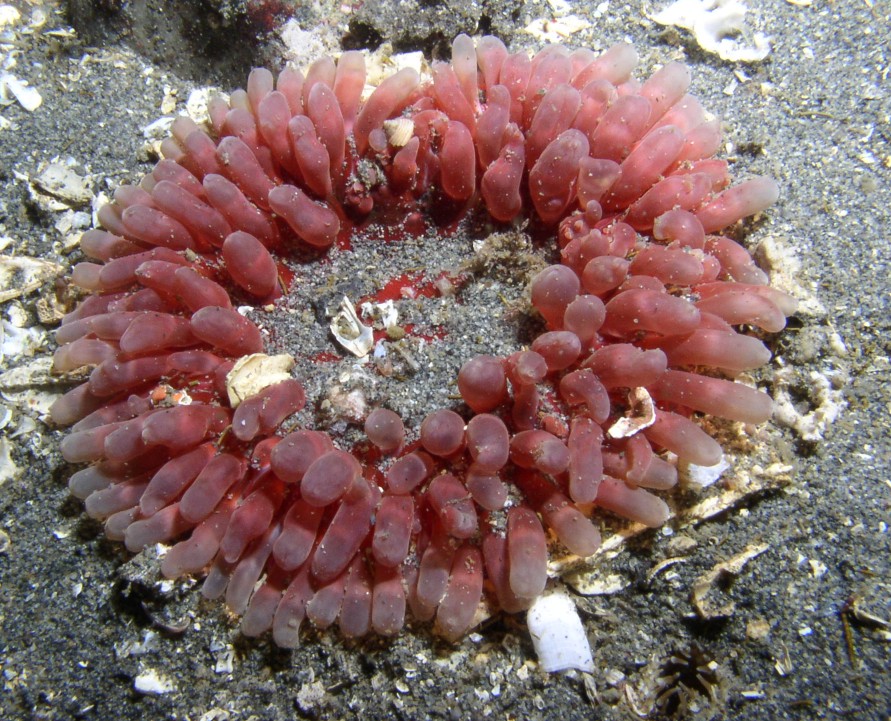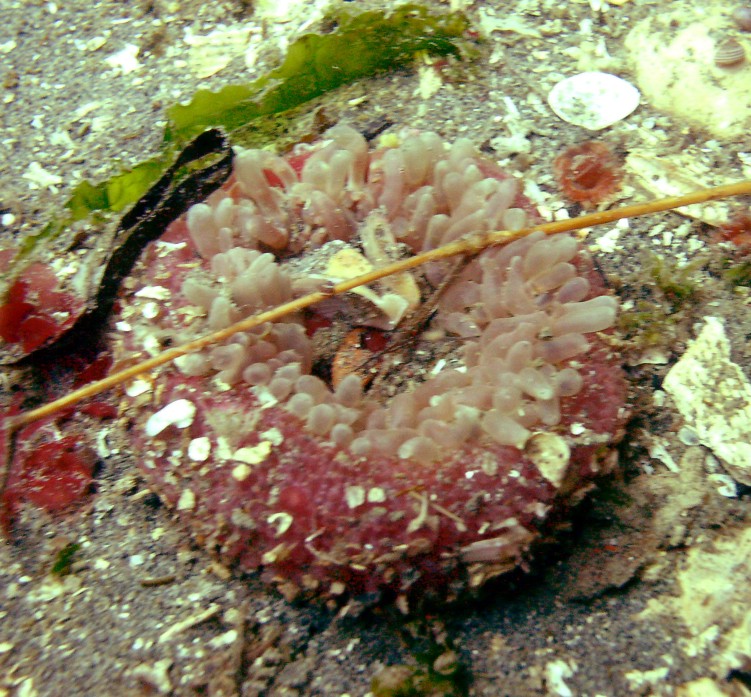Urticina coriacea (Cuvier, 1798)Common name(s): Leathery anemone, Stubby rose anemone, Scarlet anemone, Red bead anemone, Buried Urticina |
|
| Synonyms: Tealia lofotensis |  |
|
Phylum Cnidaria
Class Anthozoa
Subclass Zoantharia
Order Actiniaria
(Anemones)
Suborder Nynantheae
Family Actiniidae
|
|
| Urticina coriacea at about 13 m depth near Keystone jetty. | |
| (Photo by: Kirt Onthank, August 2007) | |
How to Distinguish from Similar Species: Of anemones with a red column, Urticina lofotensis and U. columbiana have white tubercles arranged in rows. U. crassicornis may have a red column (usually with some green) but it does not accumulate sand and gravel and its tentacles usually have broad cross-bands. Urticina piscivora also has a red column but its inconspicuous tubercles do not accumulate sand and gravel. Cribrinopsis fernaldi has spherules at the margin of the oral disk and its tentacles have fine dark red zigzag bands across them. Most of the other red-columned anemones do not bury in sand or gravel.
Geographical Range: Alaska to southern California; Europe (circumpolar)
Depth Range: Low intertidal to 45 m
Habitat: Buried in coarse sand or gravel in tidepools, subtidal, may be on rock walls subtidally.
Biology/Natural
History: This species
usually is attached to a rock below the sediment with only the oral
disk
exposed, or subtidal individuals may be attached directly to a rock and
not living in sediment. Predators include the leather
star Dermasterias
imbricata. This species may be a
species complex.
| Return to: | |||
| Main Page | Alphabetic Index | Systematic Index | Glossary |
References:
Dichotomous Keys:Flora and Fairbanks, 1967 (as Tealia coriacea)
Kozloff 1987, 1996
Smith and Carlton, 1975 (as Tealia coriacea)
General References:
American
Fisheries Society, 2002
Harbo,
1999
Kozloff,
1993
Morris
et al., 1980 (as Tealia
coriacea)
Niesen,
1997
O'Clair
and O'Clair, 1998
Ricketts
et al., 1985 (as Tealia
coriacea)
Scientific Articles:
Web sites:
General Notes and
Observations: Locations,
abundances, unusual behaviors:

Another individual. Photo by Kirt Onthank 2007
![]()
I found this individual at about 17m depth in Admiralty Bay, buried
up to the oral
disk
in shell hash. Photo by Dave Cowles, June 2020. It is 5 cm tall and 7
cm
diameter.
This species typically buries in the sediment. The sides
of the column
have small tubercles
(not lined up in rows) that are of similar color as the column.
Some of the tubercles
adhere to shell fragments or other materials. Photo by Dave Cowles,
June
2020
Authors and Editors of Page:
Dave Cowles (2008): Created original page
CSS coding for page developed by Jonathan Cowles (2007)